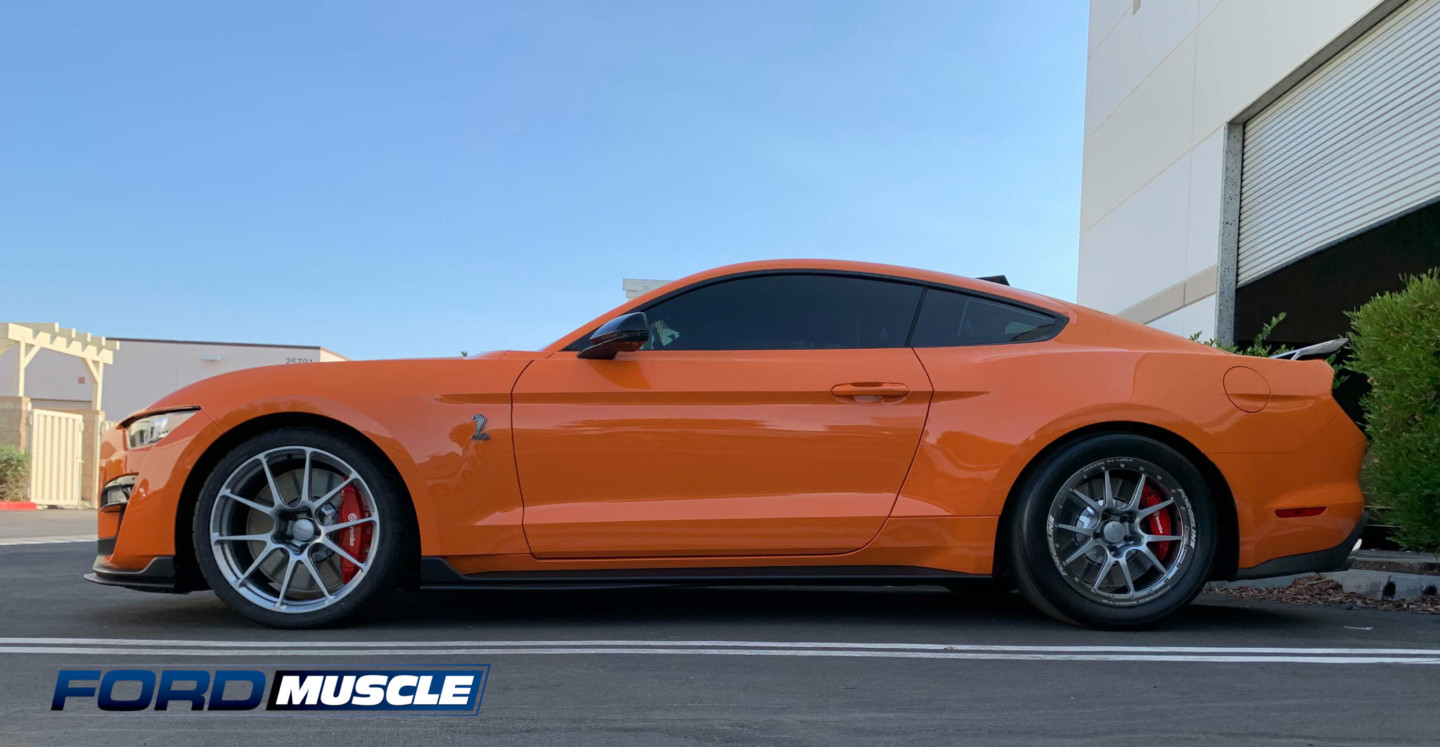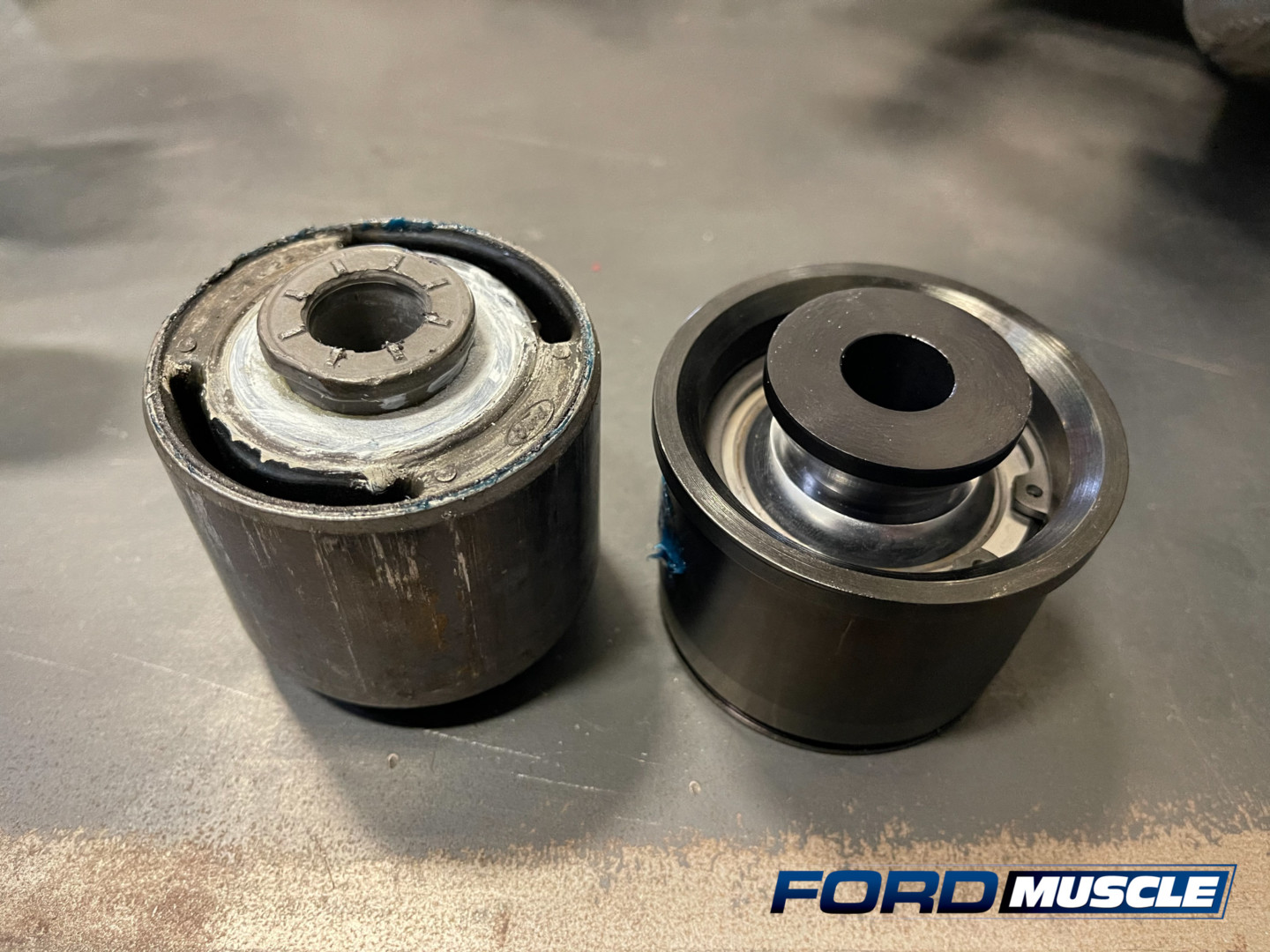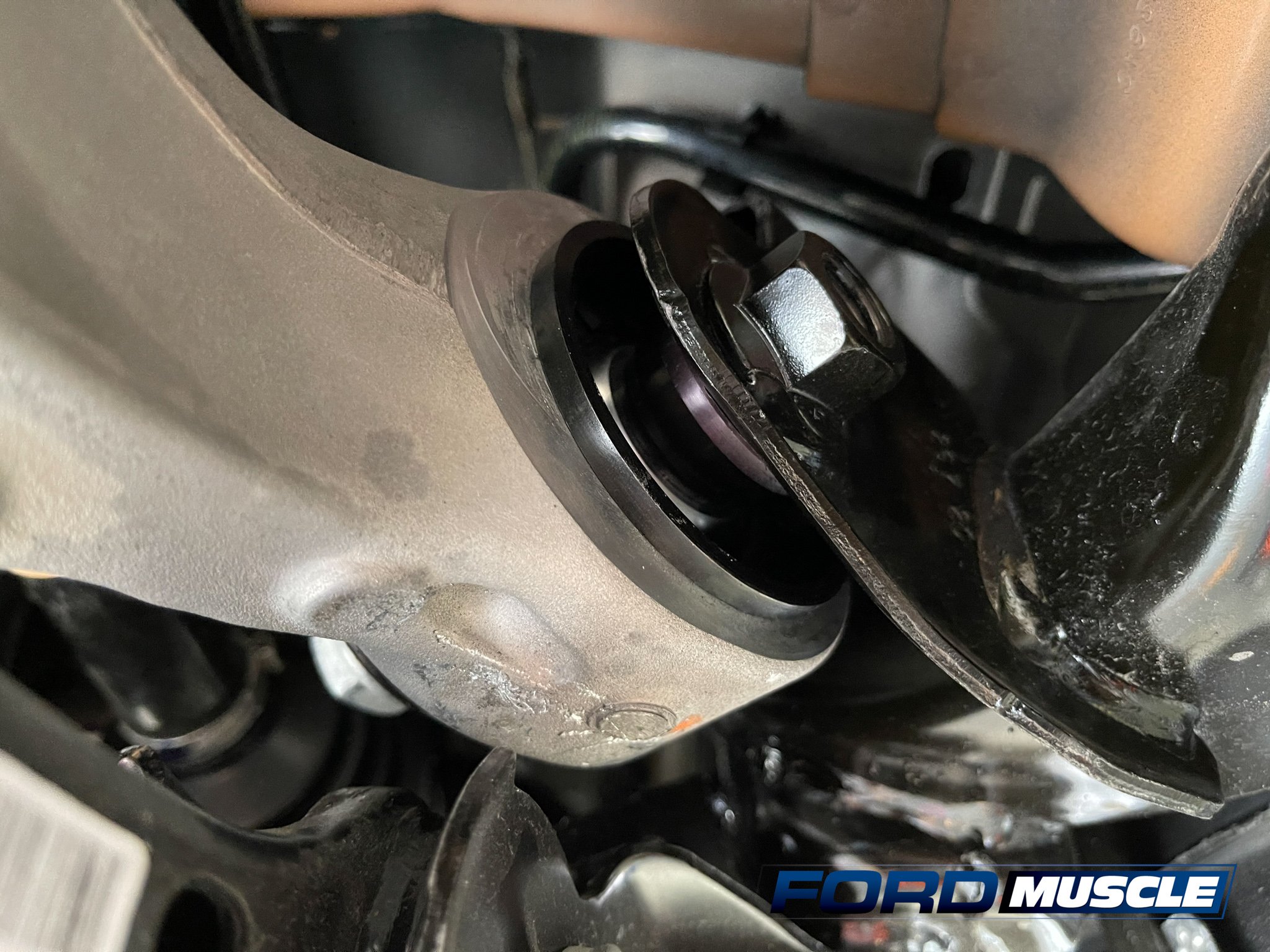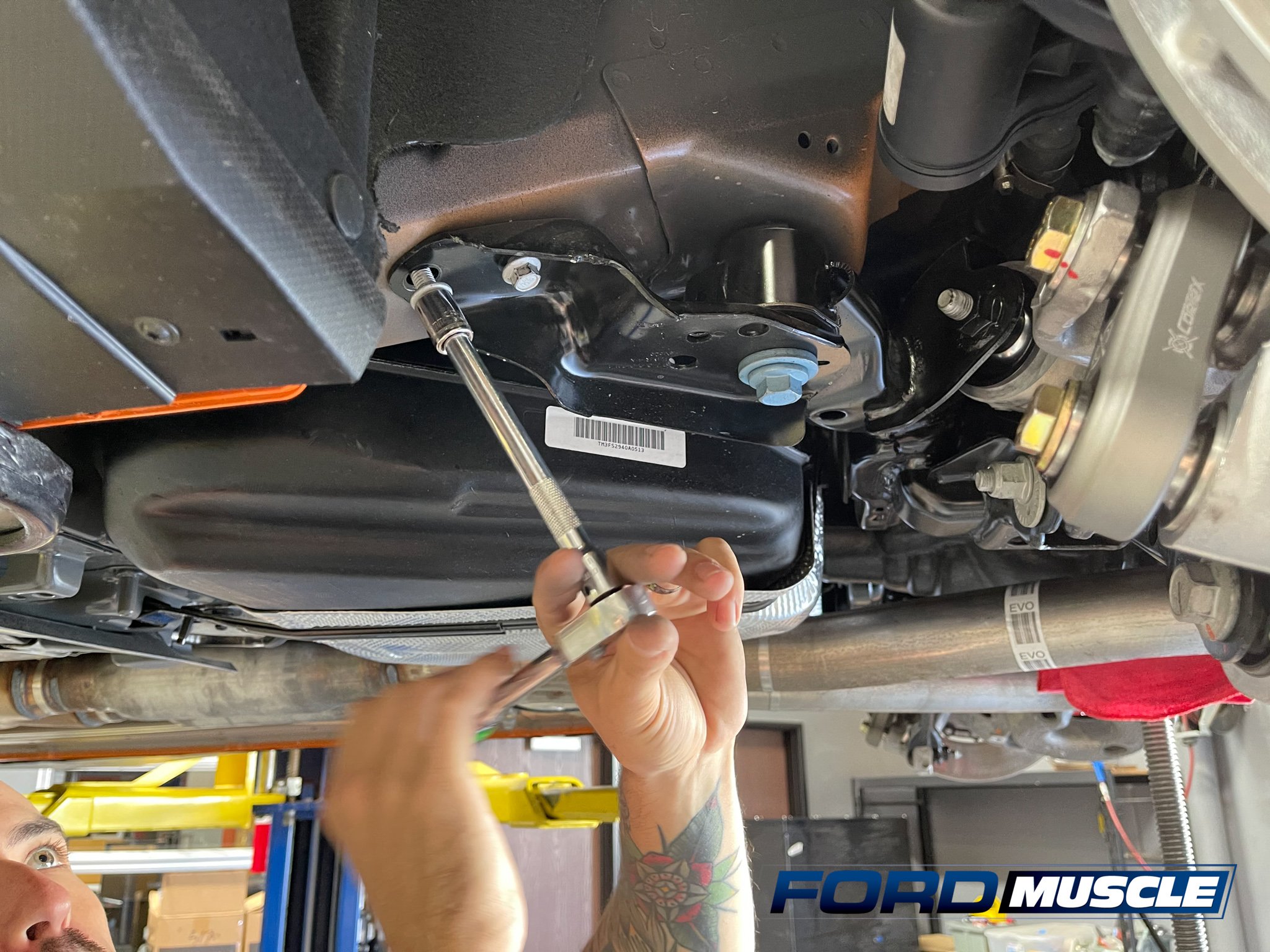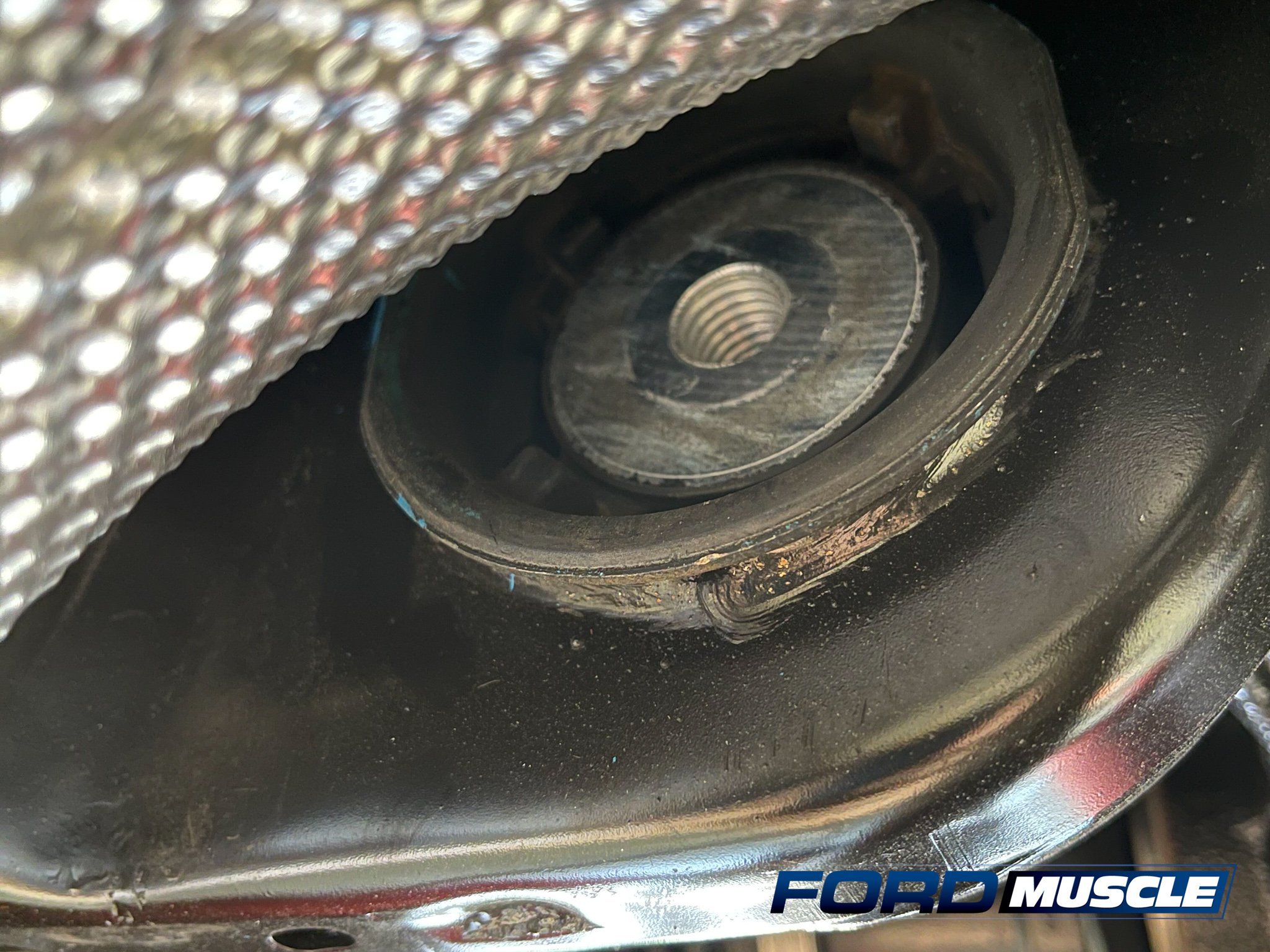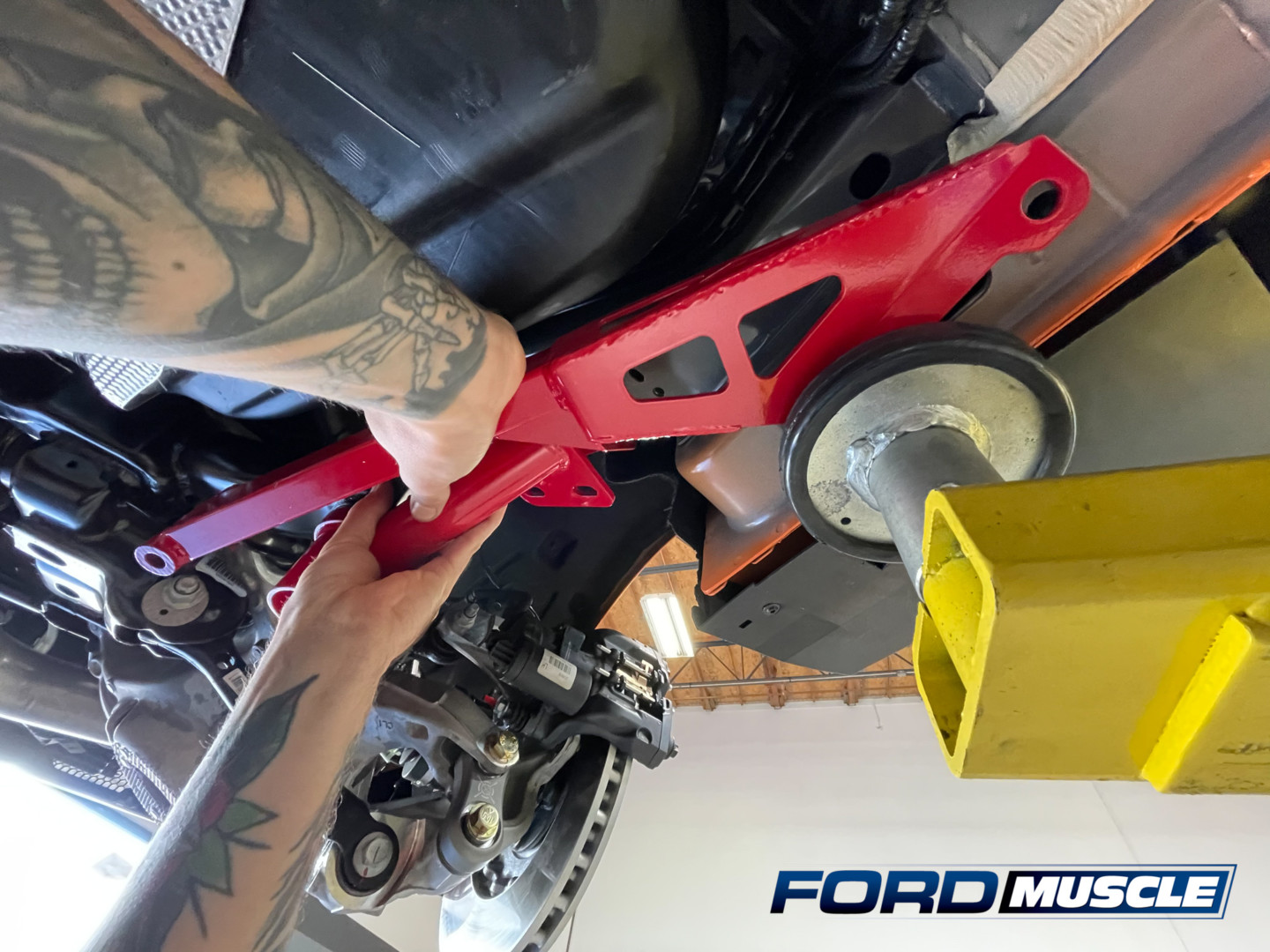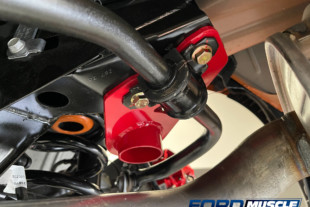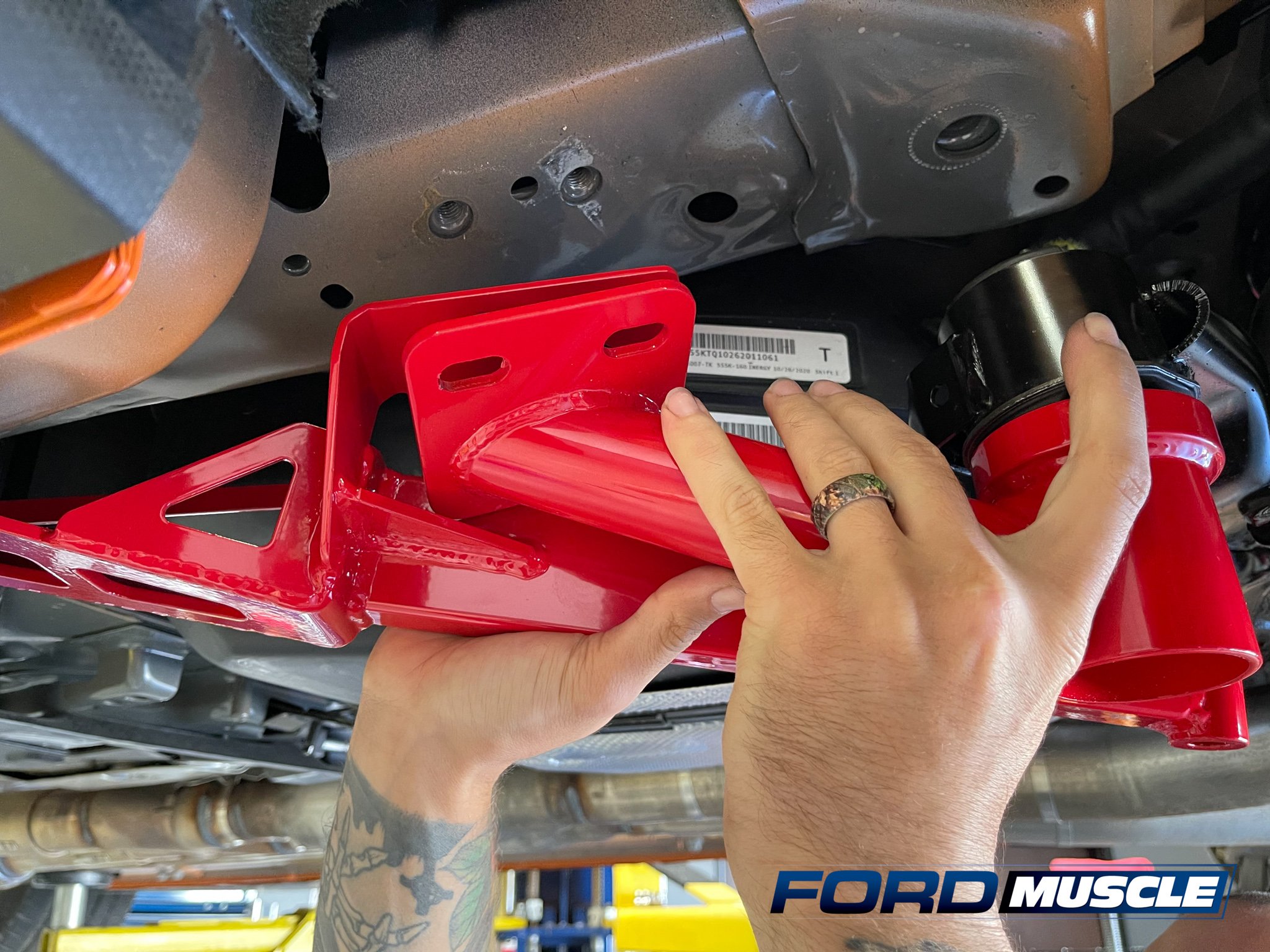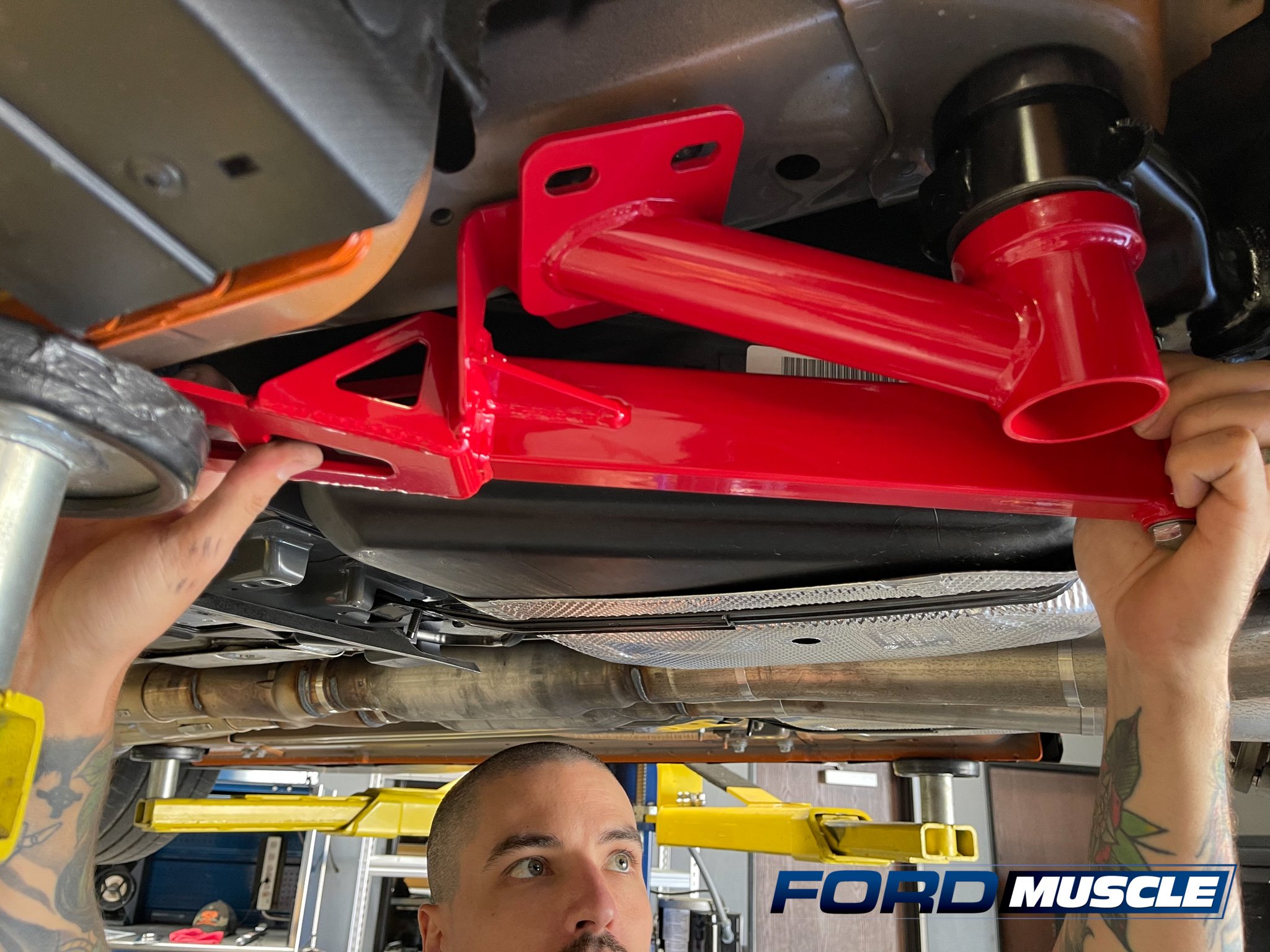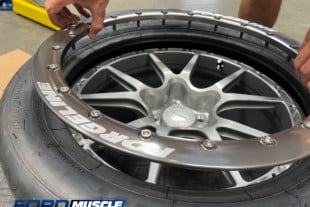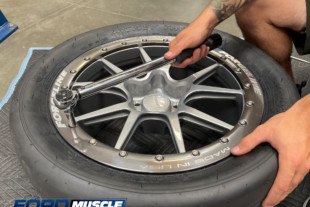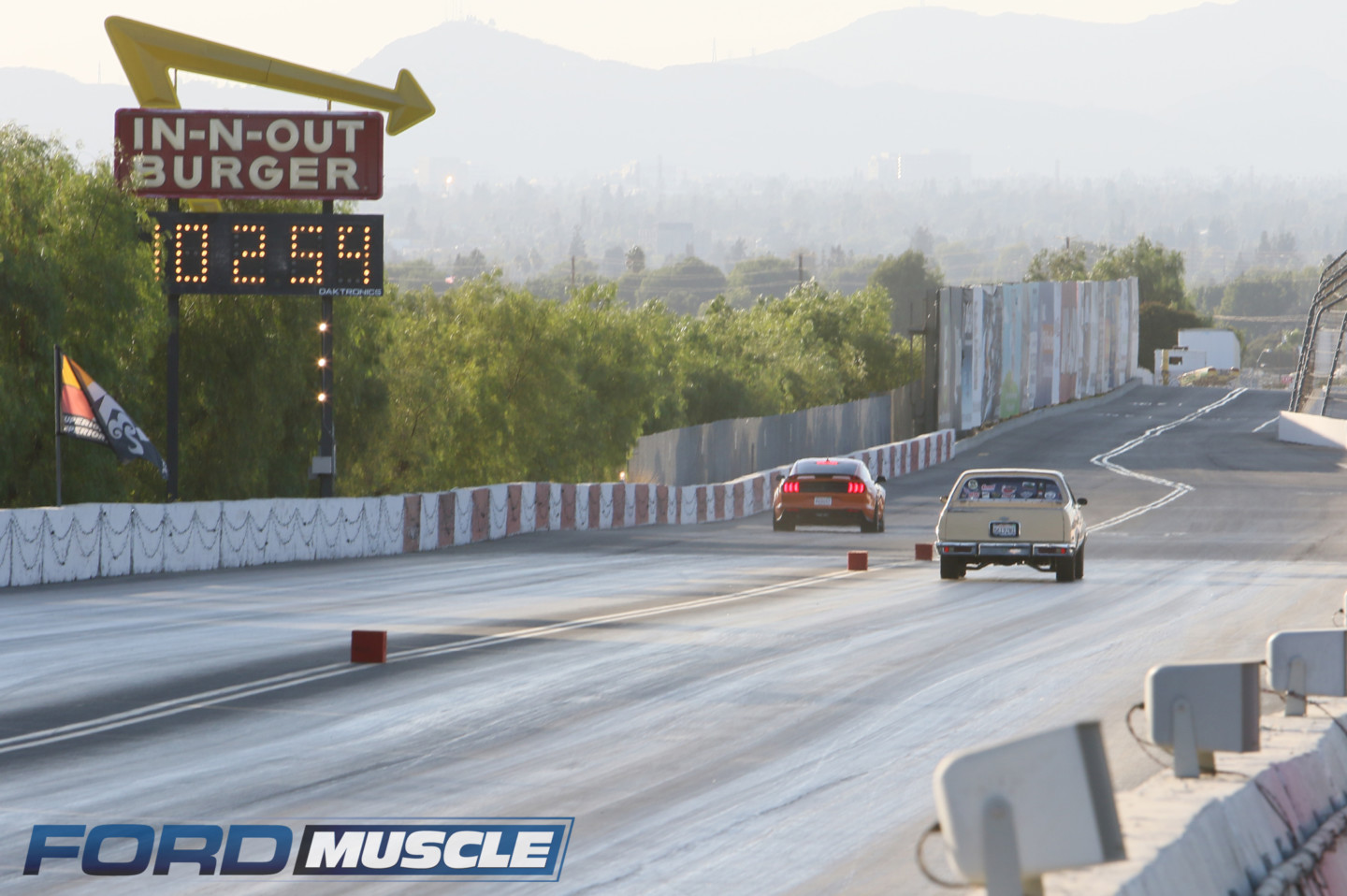“Round Two. Fight!” rang in our minds as we pushed onto the second round of testing our 2020 Ford Mustang GT500. Unlike the Street Fighter video game where pushing buttons to release random kicks and punches works, we’ve decided to take a formulated approach to produce results. In this round we focus on our suspension and tire package to hopefully improve from our last outing.
Our last round of testing involved us running on stock tires at stock power levels. Unfortunately the power of the supercharged 5.2L Predator engine was above what the track conditions could handle. A pedal fest emerged on our first pass and a scary wheel hop on the next. This resulted in us throwing in the towel for the night. Even barring these rough circumstances James Lawrence was able to crack off a 7.68 at 98.94mph. A decent time considering the track surface was not much better than a slightly prepped street.
We had planned on immediately adding power enhancing products after our baseline runs, but afterwards realized the chassis needed our attention more. We knew adding more power would only amplify the problem. It wasn’t a lack of power, but a lack of proper chassis setup holding us back. We decided to focus on chassis tuning rather than the engine. On the agenda was BMR suspension and a set of Forgeline wheels wrapped in Mickey Thompson ET Street R Drag Radials.
Our Shelby GT500 Goals
At this point I remind everyone of our goals for our 2020 Mustang GT500. While Lawrence has raced and won the NMCA series, this car will not be a test bed for building the fastest GT500 on the planet. We plan to keep this build a simple bolt-on affair. These products will showcase what modifications help and by how much. These products are intended for the GT500 owners who enjoy the car’s performance, but also like the creature comforts Ford has provided. We also want these aftermarket products to fit 100% with no permanent modifications. This allows owners to revert back to stock with no trouble. With that in mind we are continuing to improve the chassis, but also take noise, vibration and harshness (NVH) into consideration with every move.
Our first step of making this production beast track ready was to address the suspension. The 760 horsepower powerplant combined with poor track surface required a call to the good people of BMR Suspension. We discussed the issues we had and their team suggested specific parts to rectify them. Within a few days the solution arrived in the mail – including the Lower Control Arm Bearing Kit (PN BK055), IRS subframe support brace (PN CB762), Cradle Bushing Lockout Kit (PN CB005), Differential Bushing Lockout Kit (PN BK051), and Differential Hardware Upgrade Kit (PN RH017) – powder coated BMR’s trademark red. Some of the fastest GT500s run these same parts. Our mission for this round is to reduce wheel hop and wheel spin experienced in our baseline testing.
You can break axles or a driveshaft with all the wheel hop the S550 emits. If you can get rid of the wheel hop it will help the car down the track or road. Eliminating wheel hop and cradle movement even shows up with day to day driving as the car is more planted. -Dion Forbes, BMR Suspension
Cradle of Flex
We knew we had to attack the wheel hop first. On our last pass, wheel hop caused the torque management to kick on and kill any chance of a good e.t. While electronics saved our parts this time, wheel hop has the potential to cause major drivetrain damage. Damaged parts are never fun, so we decided to reduce it as best we could. To understand what parts we need, we first need to diagnose what caused the wheel hop. In the case of the S550 the major problem is cradle movement.
Lower Control Arm Bearing Kit
The stock rubber bushings are great for keeping NVH to a minimum, but at the cost of performance. BMR offers a lower control arm bearing kit that eliminates bushing deflection and allows power to be transferred instead of absorbed. These large bearings decrease the lower control arm movement when compared to OEM, which deflect under load. One-inch bearings are captured by machined bearing cups that are load rated for 10,000 pounds. That’s some serious beef.
To install the new lower control arm bearing kit, we first had to remove the control arm itself. This involved removing the bottom bolt on the vertical link and the lower sway bar end link nut. This allowed us to remove the inner and outer lower control arm bolts. Once removed we pressed the Ford bushing out and installed our BMR bearing in. Applying a little lube helped the new bearing enter its home.
BMR Differential Bushing Inserts
Since we were already this far into the chassis we decided to install BMR’s differential bushing inserts. Even though our Mustang’s rubber is new, it is still prone to break down from exposure, road salts and other harsh environments. Moreover, rubber does not have the durometer (or hardness) of polyurethane, so it stretches, flexes and bounces when we don’t want it to in a performance application. It can be another source for wheel hop. Simply put, stock rubber can’t compete with the likes of polyurethane inserts. The new bushings double as an increase in stability and preventative maintenance.
We started by loosening the two rear cradle bolts (Note: DO NOT REMOVE! Leave approximately 3/8-1/2 inch of thread engagement). We then removed the front two differential bolts. Then we removed the small bolts on the front cradle support. Finally, removing the two front cradle mounting bolts allowed us to lower the front of the cradle down. This give us ultimate access to the differential bushings.
BMR IRS Support Brace
We also added BMR’s IRS support brace. The BMR brace has more connecting points limiting the subframe movement. This will aid in preventing both wheel spin and wheel hop. Aside from having a practical usage, it also provides some awesome underbody color and looks. This product is not permanent, nor does it add any NVH, so going back to collector status is a few bolts away.
We had already loosened the Front Cradle bolt and removed the two cradle plate bolts, so it was time to install the chassis brace. We first had to insert the long 12mm bolt thru the rear of the brace Tube. NOTE: from bottom-up, the components order is; bolt, thin silver washer, brace tube, thick gold washer, the spacer going through the crossmember, another thick gold washer on top of the crossmember, and then the nut. We then replaced the rear sway bar mounting saddle.
BMR Cradle Bushing Lockout Kit
The cradle under load can move in multiple directions. The stock cradle bushings were built with NVH in mind, not performance. Unfortunately that means it does not appreciate the amount of power being thrown at it from a dig. Thankfully BMR has a solution with the IRS cradle bushing lockout kit. The kit utilizes a set of lockout rings and locating washer to secure the cradle. It is also 100% bolt-on with no modifications needed.
The way the lockout kit works is the billet aluminum upper bushing lockout rings capture the inner bushing sleeve and the outer lip of the bushing. The lower bushing location washers capture the bottom portion of the bushing’s inner sleeve. This captures both parts of the bushings’ inner sleeves and nearly eliminates any movement.
What’s great about the lockout kit is its ability to be installed with simple hand tools as no modifications are required. It is a 100% bolt on affair using existing boltholes and hardware. The lockout retains creature comforts as little to no increase in NVH was witnessed. The lockout removes 80-90% of cradle movement!
We first had loosen all four cradle mounts to allow the cradle to move slightly. Starting on one side by completely removing the twin main cradle bolts. We worked our way onto removing the front cradle support bolts. Once that was done, we lowered the jack until there was enough room to insert the upper bushing cup. NOTE: the tall cup goes on the front and short cup goes on the back. Next we installed the front BMR cradle support.
No Action Without Traction
Next on our shortlist was to attack the loss of traction. While throwing some stickies on the stock wheels might have worked, the unfortunate truth is the stock 20-inch wheels are too large to also provide good sidewall. The lower profile tires will result in less bite and more spin. We decided to go with a set of Forgeline wheels. Forgeline has been a top name in the road racing world for years now, and they just got into high-end drag wheels for street cars like our GT500. They produce extremely strong wheels that are also light and allow for large braking setups like what is found on our GT500.
For this GT500 we decided to run a set of Forgeline GS1R wheels wrapped in Mickey Thompson ET Street R. The GS1R wheels are crafted from a single forging of 6061-T6 aluminum. We wanted to maintain the correct attitude (and brake clearance) on the front and stuck with a 20-inch wheel that was 8.5 inches wide. On the rear we dropped two inches off the diameter while remaining 11-inches wide. The 18-inch wheels left enough room for us to clear the large rear calipers. We decided to take it a step further and run a beadlock setup (Gunmetal colored to offset the Satin Hypersilver spokes). This will allow us to prevent tire slip on the wheel while keeping the bead seated at high speed. Overkill? Maybe, but wheels are crucial in building a performance vehicle.
ABS equipped vehicles require the use of matching height tires. As a result, we used Mickey Thompson ET Street R Drag Radials sized at 325/35R18 on the rear and Mickey Thompson Street Comp 255/35R20 on the front. This resulted in a magic number of 27 inches tire height, but also a 13.1-inch section width (in the rear). The end result was matched tire height, large section width and no gear change required.
We first started by mounting the tire to the wheel. After that we applied anti-seize to each bolt. We then put every bolt and washer through the BeadLock ring to mate to the wheel. We hand tightened bolts in the 3, 6, 9 and 12 position. Then we hand tightened the remaining ones. Each bolt was then torqued to spec as we went in a star pattern.
Results
So after we performed all these modifications it was time to see where we stand. Drag strips offer little to no consistency (between weather, prep and usage), but for our testing purposes we headed back to Irwindale. As with last time, our first pass was our quickest and fastest. On the first hit we left at idle and the GT500 blasted down the eighth to the tune of 7.2 at 102 mph. This is almost half a second faster and picked up over 3 mph on the top end. In the sixty-foot we dropped almost a full tenth, going from a 1.89 to a 1.80. These are huge gains for any drag racer. On a sticky surface where we could actually use the launch control (to leave above idle) these gains would be exponentially better. Subsequent runs leaving harder only resulted in more wheel spin.
We spoke to BMR after the track test, who told us to plan on adding a few more upgrades as we increase power. Our rear alignment is of particular note, as we’ll need to keep the rear camber as close to zero as possible. At the moment, though, better track conditions are the only way to get faster.
What’s next for our GT500?
Now that the frustrating experience of chassis wheel hop or spin has been reduced we can start our transition into making more power! The struggle will no longer be chassis related, but a restraint against our horsepower loving shop. I know I’ll constantly check back to the drawing board in the hopes “bolt-ons and E85” have been replaced with “larger blower and nitrous.” Sadly though that is not our goal with this build. So get ready for next edition as we swap pulleys, add a few bolt-ons and bring on the corn juice to this amazing GT500. And, yes, we are doing everything we can to test during better conditions, too!




